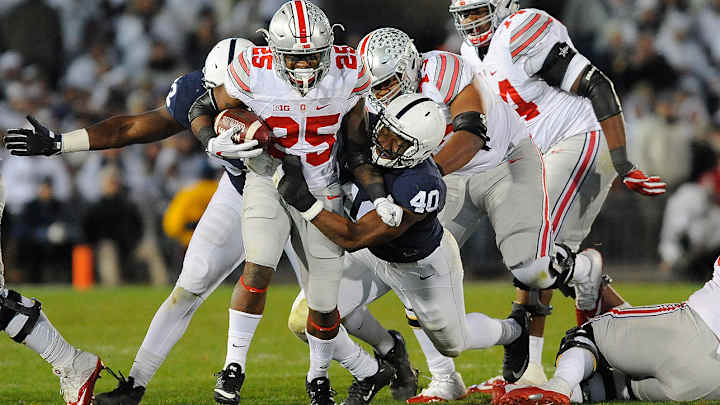The Big Ten Isn't Losing Sleep Over Its Lopsided Divisions

CHICAGO — At Big Ten Media Days on Monday morning, Ohio State coach Urban Meyer was discussing the caliber of play in his division, which saw three of its teams ranked in the AP’s top 10 to end 2016, and he drew upon a comparison from his previous job as Florida’s head man from 2005 to ’10. “I've coached in the SEC East when that was one of the strongest in the country,” he said. “And I think the Big Ten East right now is every bit as strong as I can remember the SEC East.”
And there, without even being asked, without even directly addressing it, Meyer cut to the core of the perceived imbalance between the Big Ten’s East and West Divisions: It exists, but it won’t forever. Granted, during Meyer’s SEC years, there was never true divisional imbalance, but the East held its own with the West, often finishing with as many ranked teams. Now? It has been considered the weaker of the two divisions by a wide margin for the past few seasons, with the West consistently fielding more ranked teams. In fact—in large part thanks to Alabama’s dominance—no SEC East squad has won the conference’s title game since Meyer’s Gators did in 2008.
The SEC East has risen and fallen, and so too will the Big Ten East, and West, and most other divisions across the Power 5. Granted, the East’s eventual dropoff might not be precipitous, but before we start bemoaning what Jim Delany and company have done with their conference’s divisions, let’s pause for a breath—or a couple of years.
This Is How Penn State Needs To Recruit To Win in the Big Ten East
“We’re talking about this time period, this year,” said Penn State coach James Franklin, who coached at Vanderbilt during the SEC East’s downturn. “But yeah, I think whenever you have Penn State, Michigan, Michigan State and Ohio State, [it’s imbalanced]. But year in, year out, that fluctuates. It’s hard to have a perfect system.”
Last season, Ohio State (No. 6), Penn State (No. 7), Wisconsin (No. 9) and Michigan (No. 10) all finished in the AP’s top 10. Only the Badgers hailed from the Big Ten West, and they lost the conference championship game to Penn State, which failed to make the College Football Playoff despite that win and an in-season victory over Ohio State, the Big Ten’s lone CFP representative. Although no coach with whom SI.com spoke at the conference’s media days in Chicago this week believed the imbalance was hurting the conference’s chances to get a team in the playoff each year, Franklin did say he believes the uneven conferences kept his program specifically from a playoff berth. The Buckeyes and Nittany Lions were the only Big Ten teams with just one conference loss, but only one got to compete in the championship game, against a Wisconsin team that lost twice in Big Ten play. That certainly muddied the waters for the playoff committee.
#DearAndy: Three Overlooked Angles of the Hugh Freeze Fallout
Still, the East’s superiority didn’t lead to a scenario in which the division cannibalized itself entirely out of the playoff. And around college football, the imbalance is a talking point; it’s hard to imagine a coach or decision-maker discounting the grueling schedule of a team in the East. “From an outsider looking in, before I got in, I think we all know who the best teams in the conference are,” said Purdue coach Jeff Brohm, who was hired this winter from Western Kentucky. “If you consider [the division] top-heavy, I think a lot of times it ends up leveling itself out after so many years. So I do think there’s very good teams on both sides. I think while one might be ahead this past year, that could easily change.”
Tom Allen, Indiana’s first-year coach, got a crash course in what it’s like to be near the bottom of the Big Ten East in 2016 as the Hoosiers’ defensive coordinator. It was his first season in the conference, and his team lost to all three top-10 teams from the East, just as it did in ’15, just as it did in ’14. In fact, last fall might have seemed like something of a reprieve; Michigan State, typically a powerhouse, sputtered, and the Hoosiers beat them, 24–21.
“You tell your players, you focus on what you can control, and I have zero control over [the divisions],” Allen said. “There’s no question that one side has, at least from the rankings perspective, a different group of teams. We use it to our advantage. I talk about the quality of the teams in our division, and we use it in recruiting. I like it. It’s hard, but I like it.”
P.J. Fleck's Big Ten Media Days Debut Was Just As Energetic As You'd Expect
The conference’s current divisions were instituted for the 2014 football season, replacing the geographically scattered and inherently mockable Legends and Leaders. We’ve had such a small sample size, and already Michigan State and Penn State have declined and improved, respectively. Michigan has returned in full force from the Brady Hoke era, and Nebraska and Wisconsin have both flourished under new coaches. In another year, who knows which other teams’ fates will have reversed? If conferences were to realign every time the scales tipped one way—no matter how dramatically—sports would be a mess. In baseball, the NL West would need to be broken up if it holds on to both wild-card spots this season, just two years after three teams from the NL Central were good enough to earn playoff spots. In the NBA, the majority of the Eastern Conference might have been relegated to the D-League.
That is to say, let’s all just take a breather. Another season of Big Ten East cannibalization will be nothing if not nail-biting (both in games and in playoff committee deliberations), and when Purdue is battling Illinois for the Big Ten’s best record in 2027, we’ll barely remember this bygone era.
